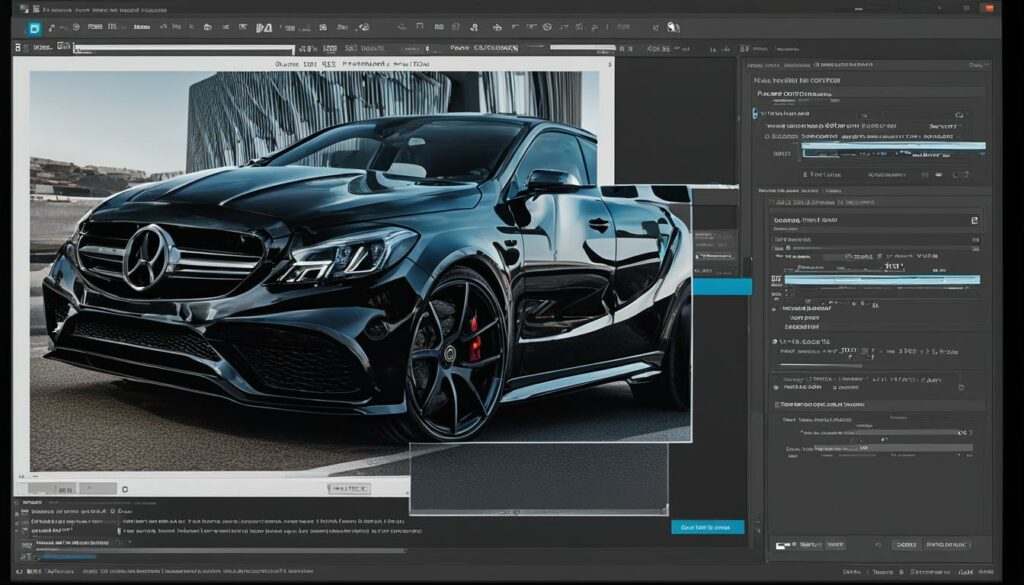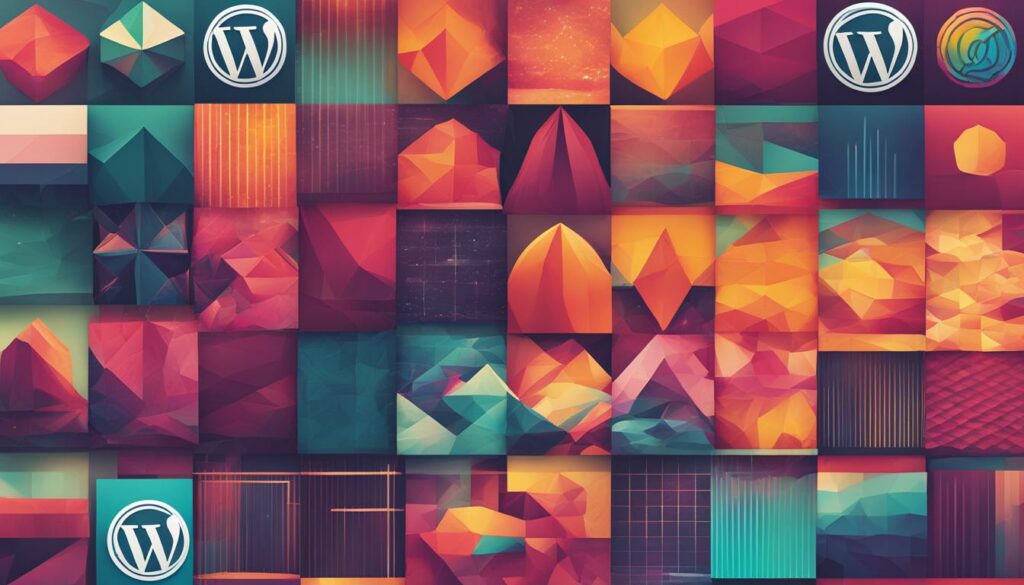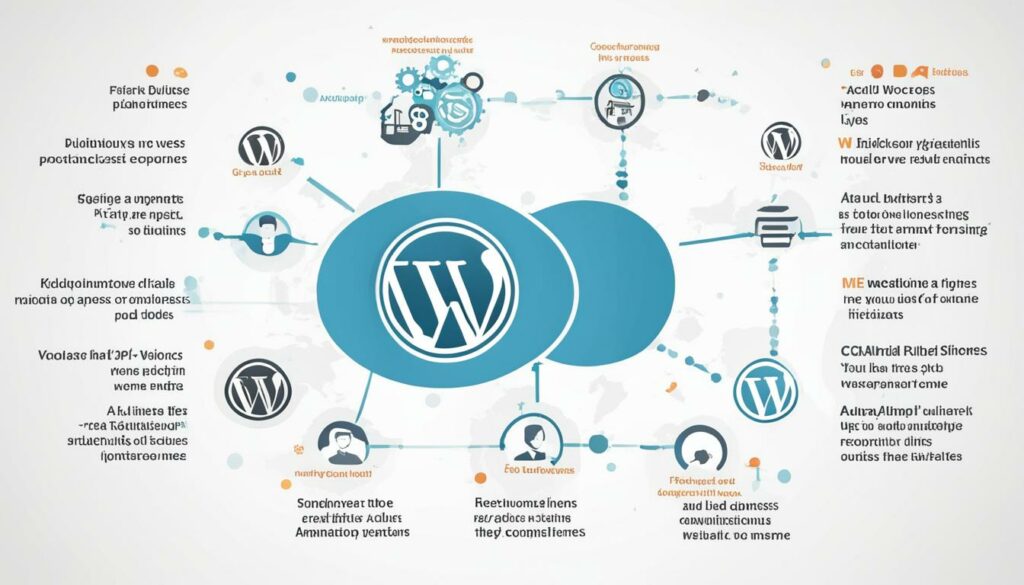In today’s digital age, having a visually appealing website is crucial for attracting and engaging visitors. WordPress, being one of the most popular content management systems, offers a multitude of features to create visually stunning websites. However, it’s important to manage your WordPress image sizes effectively to ensure optimal performance and faster load times.
WordPress image optimization plays a key role in improving your website’s overall speed and performance. By optimizing image sizes, you can enhance user experience, reduce bandwidth consumption, and boost your search engine rankings. In this article, we will delve into the best practices for managing image sizes in WordPress and provide you with actionable tips to optimize your WordPress images for speed and performance.
To get started, let’s explore the various ways you can manage your image sizes in WordPress:
Key Takeaways:
- Optimizing image sizes is essential for improving website performance and load times
- WordPress provides default image sizes – thumbnail, medium, large, and full size – with different uses
- You can adjust the default image sizes to fit your website layout and responsive design
- Add custom image sizes only if necessary, considering their impact on server storage and performance
- Choosing the perfect image sizes for different purposes on your site ensures optimal performance and user experience
Now that you have a brief overview of what we’ll cover in this article, let’s dive deeper into each topic and learn how to effectively manage your WordPress image sizes for optimal performance.
Uploading Images in WordPress
Uploading images in WordPress is as easy as pie. Whether you want to spruce up your blog posts or add visual flair to your pages, WordPress makes it a breeze. You have two options to upload images: the Block Editor and the Media Library. Let’s take a closer look at both methods.
Block Editor
When creating or editing a post or page, simply click on the (+) icon to add a new block. Then, select the “Image” block. You can either upload an image from your computer or choose one from the Media Library. After uploading, you can fine-tune the image alignment, size, and caption right within the Block Editor.
Pro Tip: Remember to optimize your images for search engines by giving them descriptive file names and writing alt tags. This helps improve SEO and accessibility for your site.
Media Library
If you prefer managing your images from a centralized location, the Media Library is your go-to tool. Accessible from the WordPress dashboard, the Media Library allows you to upload, organize, and edit all your site’s images in one place. You can easily browse through your uploaded images, search for specific ones, and perform bulk actions like deleting or updating metadata.
Want to see an example? Here’s an image of a cute puppy uploaded using the Media Library:
| Advantages of Uploading Images in WordPress | Disadvantages of Uploading Images in WordPress |
|---|---|
|
|
Whichever method you choose, uploading images in WordPress opens up new possibilities for creativity and engagement. Now, let’s dive into the default image sizes in WordPress and how you can customize them to fit your site’s needs.
Default WordPress Image Sizes
WordPress comes with default image sizes that are automatically generated for every uploaded image. These sizes include thumbnail, medium, large, and full size. Understanding these default image sizes is important for optimizing your WordPress site.
The thumbnail size is specifically designed for small images that are displayed in blog feeds. This size allows for quick loading and optimal display in feed layouts. The medium and large sizes, on the other hand, are ideal for displaying images within your posts. They provide a balance between image quality and file size.
The full-size option preserves the original dimensions of the uploaded image. This size is useful when you want to display the image at its original resolution or when you need a larger version for specific purposes on your site.
When inserting images into your posts or pages, you can easily select one of these default sizes to ensure proper display. Additionally, you have the option to adjust the default image sizes in the WordPress Media Settings to meet your specific requirements.

| Image Size | Dimensions | Usage |
|---|---|---|
| Thumbnail | 150×150 pixels | Small images in blog feeds |
| Medium | 300×300 pixels | Image display within posts |
| Large | 1024×1024 pixels | Image display within posts |
| Full Size | Original dimensions | Preserves original image resolution |
Using the default image sizes in WordPress provides a convenient way to ensure consistent and optimized image display across your website. However, if these sizes do not meet your specific needs, you can always adjust them or even create custom image sizes to suit your requirements.
Adjusting Default Image Sizes
If the default image sizes in WordPress do not meet your requirements, you have the flexibility to adjust them according to your needs. This can be easily achieved by making changes in the Media Settings of your WordPress dashboard.
When adjusting the default dimensions for each size, it is important to take into consideration your website layout and responsive design. By customizing the image sizes, you can ensure that they fit perfectly within your desired design scheme and are displayed optimally across different devices.
Optimizing image file sizes is another important aspect of managing default image sizes. By reducing the file size of your images without compromising the quality, you can significantly improve your website’s performance and reduce load times. This is particularly crucial for maintaining a smooth user experience.
Remember to strike a balance between image quality and file size. Your goal is to achieve optimal performance while still maintaining visually appealing images.
Now let’s take a look at how you can customize the default image sizes:
- Log in to your WordPress dashboard.
- Navigate to the “Settings” tab and click on “Media”.
- Within the “Image sizes” section, you will find the default dimensions for thumbnail, medium, and large sizes.
- Adjust the dimensions according to your requirements. Keep in mind the aspect ratio and how the images will fit within your website layout.
- Once you have made the necessary changes, click on the “Save Changes” button to apply the new default image sizes.
By following these simple steps, you can easily manage and customize the default image sizes in WordPress to better suit your needs. Remember to optimize the image file sizes to enhance your website’s performance and speed.
Now that you know how to adjust the default image sizes, let’s move on to the next section where we will explore how to add custom image sizes to WordPress.
Key Takeaways
– Adjusting default image sizes in WordPress is essential for ensuring images fit your website layout and responsive design.
– Optimizing image file sizes can significantly improve website performance and reduce load times.
– Customizing default image sizes can be done through the Media Settings in your WordPress dashboard.
– Keep a balance between image quality and file size to achieve optimal performance and visually appealing images.
Adding Custom Image Sizes to WordPress
In addition to the default image sizes provided by WordPress, you have the flexibility to create custom image sizes tailored to your specific needs. This allows you to optimize image display and ensure a consistent user experience throughout your website.
One way to add custom image sizes is by using the Image Regenerate & Select Crop plugin. This plugin offers advanced image settings and enables you to easily define and manage custom sizes. Simply install and activate the plugin, navigate to the plugin settings, and follow the instructions to create your desired custom image sizes.
However, it is important to consider the potential impact of adding too many custom image sizes on your server storage and website performance. Each custom size you define will generate additional image files, potentially increasing the file storage required and slowing down your website’s loading speed. Therefore, it is advisable to only create the custom image sizes that are necessary for your site’s design and functionality.
By carefully selecting the custom image sizes that are truly essential, you can strike a balance between optimizing your website’s image display and maintaining optimal performance.
Example: Custom Image Sizes
| Image Size | Dimensions | Usage |
|---|---|---|
| Featured Image | 1200 x 900 pixels (landscape) 900 x 1200 pixels (portrait) |
Showcased on blog posts or pages |
| Header Image | 1920 x 1080 pixels | Displayed at the top of your website |
| Thumbnail | 150 x 150 pixels | Used in image galleries or post excerpts |
| Custom Project Image | 800 x 600 pixels | Specifically designed for project showcases |
The example table above illustrates how custom image sizes can be defined according to different usage scenarios on your WordPress site. By tailoring image sizes to specific sections or page templates, you can ensure the images are displayed optimally while maintaining a visually appealing layout.
Keep in mind that in addition to adding custom image sizes, it’s important to optimize your images for web usage by applying compression techniques and choosing the appropriate image formats. These steps can further enhance your website’s performance and user experience.
Creating custom image sizes in WordPress allows you to have greater control over the visual presentation of your website while ensuring an optimal user experience. By carefully defining the necessary sizes and optimizing your images, you can showcase your content in the best possible way and enhance your site’s performance.
Choosing the Perfect Image Sizes
Selecting the perfect image sizes plays a crucial role in optimizing the performance and enhancing the user experience of your WordPress site. When determining the ideal image sizes, it’s essential to consider factors such as the type of content, website layout, and specific requirements. By choosing the right image sizes, you can ensure that your visuals are displayed optimally across different devices and layouts.
For featured images, landscape dimensions of 1200 x 900 pixels or portrait dimensions of 900 x 1200 pixels are commonly recommended. These dimensions strike a balance between image quality and file size, providing a visually appealing experience while maintaining website performance.
For header images, it’s best to select a 16:9 aspect ratio, such as 1920 x 1080 pixels. This ratio ensures that the header image fits well on most devices and maintains a consistent presentation across various screen sizes.
It’s also crucial to consider the responsiveness of your website and the devices your visitors use. By selecting image sizes that adapt well to different screen resolutions, you can provide a seamless browsing experience for your audience.
Remember, choosing the perfect image sizes is an opportunity to optimize your website’s performance and enhance user engagement. Take your time to evaluate your content and design, keeping in mind the best practices for image sizing in WordPress.
“Selecting image sizes that adapt well to different screen resolutions ensures a seamless browsing experience for your audience.”
Image Compression and Optimization
Image compression and optimization play a vital role in improving your website’s performance and reducing load times. By compressing images before uploading them to your WordPress site, you can significantly reduce their file sizes without compromising on image quality. This not only improves the overall speed of your website but also enhances the user experience.
One effective tool for image compression within the existing dimensions is TinyPNG. This user-friendly tool allows you to easily compress JPEG and PNG images without affecting their dimensions, resulting in smaller file sizes. By compressing every image you upload to your site, you can maximize website performance and ensure faster load times.

In addition to manual compression, you can also automate the image optimization process using WordPress plugins like EWWW Image Optimizer. These plugins automatically compress the images you upload, saving you time and effort while still achieving optimal performance.
Effective image compression and optimization can significantly improve your website’s performance, making it more responsive and user-friendly. By reducing image file sizes, you can enhance loading speeds and provide a seamless browsing experience for your visitors.
Image Formats and DPI Considerations
Different image formats and DPI settings play a crucial role in optimizing image quality and file sizes on your WordPress site. Understanding the advantages and disadvantages of each image format is essential for making the right choices. Let’s explore image formats and DPI considerations in WordPress.
Choosing the Right Image Format in WordPress
When it comes to image formats in WordPress, two popular options are JPEG and PNG.
| Image Format | Advantages | Disadvantages |
|---|---|---|
| JPEG | • Smaller file sizes • Vibrant colors and gradients |
• Lossy compression affects image quality • Doesn’t support transparency |
| PNG | • Supports transparency • Lossless compression maintains image quality |
• Larger file sizes • Limited color depth |
For photographs or images with complex color gradients, JPEG is a great choice. Its smaller file sizes help ensure faster loading times. On the other hand, PNG is ideal for graphics, logos, or images with transparency requirements. Choose the format that best suits your content and design needs.
Understanding DPI Settings for Web Images
DPI (dots per inch) refers to the resolution of an image, determining the level of detail and clarity. In web design, the standard DPI for images is 72. This resolution is suitable for screen display, ensuring optimal image quality without unnecessarily large file sizes.
Did you know? Higher DPI values are typically used for printing purposes, where image quality is essential in producing sharp and detailed prints. For web images, 72 DPI is the standard as it strikes a balance between quality and file size.
It’s important to note that changing the DPI value of an image doesn’t affect its actual resolution. The DPI value only determines how the image is displayed on a physical medium, such as a printer. For web images, focus on optimizing file sizes and dimensions rather than altering the DPI setting.
By understanding the appropriate image formats and DPI settings in WordPress, you can optimize your images for better performance, faster loading times, and enhanced visual appeal.
Conclusion
Managing WordPress image sizes is crucial for optimizing your website’s performance, improving load times, and enhancing user experience. By understanding the default image sizes in WordPress, adjusting them to fit your specific needs, and utilizing custom image sizes when necessary, you can ensure that your images are displayed optimally across different devices and layouts.
One important aspect of image optimization is compression. By compressing your images, you can significantly reduce their file sizes without compromising quality. This not only helps improve website performance and speed but also reduces bandwidth usage for your visitors. Additionally, choosing the right image formats, such as JPEG for photographs and PNG for graphics, can further enhance image quality and contribute to better overall performance.
Take the time to optimize and manage your WordPress image sizes for optimal performance and better SEO. By following best practices for image sizing, compression, and format selection, you can create a visually appealing and fast-loading website that provides a seamless user experience. Remember, investing in image optimization is an investment in the success of your website.
FAQ
How do I upload images in WordPress?
You can add images to your posts and pages directly through the Block Editor or upload them to the Media Library. Make sure to give your images descriptive names and write alt tags for better SEO optimization.
What are the default image sizes in WordPress?
WordPress automatically generates four different image sizes: thumbnail, medium, large, and full size. Thumbnail is used for small images in blog feeds, while medium and large sizes are used within posts. The full-size option preserves the original image size.
How can I adjust the default image sizes in WordPress?
You can change the default dimensions for each size in the Media Settings of your WordPress dashboard. Customize the image sizes to fit your needs and consider the impact on website performance.
Can I add custom image sizes to WordPress?
Yes, you can create custom image sizes using plugins like Image Regenerate & Select Crop. Just be mindful of the impact on server storage and website performance.
How do I choose the perfect image sizes for my WordPress site?
The ideal image sizes depend on your content type, layout, and specific requirements. For featured images, landscape dimensions of 1200 x 900 pixels or portrait dimensions of 900 x 1200 pixels are commonly used. Consider responsiveness and device types when selecting image sizes.
How can image compression and optimization improve performance?
Compressing images before uploading reduces file sizes without sacrificing quality. Tools like TinyPNG can help with compression within current dimensions. Image optimization plugins like EWWW Image Optimizer can automate the process.
What image formats and DPI settings should I use in WordPress?
JPEG is ideal for photographs with vibrant colors and smaller file sizes. PNG is suitable for graphics and logos with transparency needs. A standard web image has a DPI of 72, while higher DPI values are for printing purposes.











